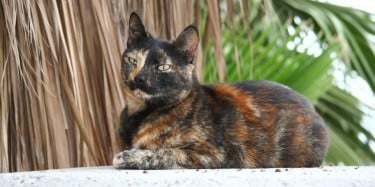
The speckled beauty of the feline world is the tortoiseshell cat, sometimes known as the tortie cat. These cats have a design that is genuinely unique, making them both stunning and eye-catching (at least to cat lovers!). Torties are notorious for their constant energy and loud, flamboyant attitudes. This mostly female bunch isn’t afraid to give some shit to others, but they also don’t take any!
Let’s examine some interesting trivia and often asked questions on the multicolored tortie. For instance, what distinguishes a calico cat from a tortoiseshell? Is it true that tortitude exists? To find out, continue reading.
Tortoiseshell isn’t a breed
“Tortoiseshell” isn’t a specific breed of cat, just like tabby and calico. Despite having numerous distinctive characteristics that give the impression that they belong to a distinct breed, tortoiseshell cats really come in a variety of forms. Because of the resemblance of their fur pattern to the now-banned tortoiseshell material made from the shells of larger species of tortoise and turtle (though synthetic tortoiseshell is still widely used), tortie cats got their name. Cats of both purebred and mixed breeds may exhibit this pattern.
This fur pattern is distinctive enough that only a very particular type of cat—one that is gregarious and a wonderful companion—should wear it.
Types of Tortoiseshell Cats
There are numerous subcategories within the cryptic coat patterns of tortoiseshell cats, as if they weren’t already strange enough! These complement the conventional color scheme occasionally referred to as mosaic tortie.
Bridled
A tortie’s coat is deemed bridled if the colors seem to be woven together. It will get easier to see all of these little differences the more obsessed you get with tortie cats.
Light-Coated Tortie Cat
Then there is the diluted tortoiseshell coat, which is caused by genes that are recessive and produce hues of fur that are “softened.” You’ve probably encountered a dilute tortoiseshell cat if you’ve seen a tortie cat with softer, pastel-like colors like cream, lilac, or cinnamon. And, boy, are they amazing!
Tabby tortoiseshell cat
In search of more? You only need to look at the patched “torbie,” or the point where tortie joins tabby. The torbie usually has patches of orange and brown tabby stripes, with the markings being more noticeable on the head and legs.
Chimera tortie
The most amazing of them is the chimera tortie, in which two embryos fuse together in the womb to become a single animal. One side of a chimera tortoiseshell cat’s body is one color, while the other has a different hue.
Tortoiseshell cat personality
Tortoiseshell cats are known for their feisty personalities! They are often described as independent, strong-willed, and sometimes even sassy. But they’re also loving and loyal to their humans. They’re smart and curious, and they love to explore and play. Some tortoiseshell cats can be a bit vocal, and they’re known for being “talkative” kitties. They can also be very affectionate and cuddly.
They’re referred to by some as the cat world’s divas. According to Jackson Galaxy, tortoiseshell cats tend to be “more sensitive to the stimulus around them” and have unique psychological features.
A 2016 study from the UC Davis Veterinary Medical Teaching Hospital gave tortitude some scientific support, but in the end, the researchers were unable to discover any connection between fur patterns and behavior, temperament, or distinctive personality. On this one, we’ll allow the mountains of anecdotal evidence do the talking!
Torties, for example, will notify you by defecating next to their dirty litter box unless you purchase a self-cleaning litter box if theirs isn’t clean enough for their liking. In this manner, all kids have to ask for from you is your love and affection.
You can probably testify to the brazen and dominant nature of tortie cats if you own one. Furthermore, the lack of scientific evidence does not imply that anything is false.
Tortoiseshell Cat Lifespan
Because tortie cats exist in so many distinct breeds, their life spans varies. Across all breeds combined, tortoiseshell cats have an average lifespan of 14 to 18 years, although they can generally live long, happy lives—some reaching the age of 20 or more.
Male tortoiseshell cats are not as fortunate as female ones, and because of their rarity and various health problems, they typically live much shorter lives. If you do end up with a unique male tortie, you will need to monitor their health and take them to their regularly scheduled veterinary appointments.
In the end, the tortoiseshell cat’s lifespan usually comes down to what breed of tortie you have. Their fur and coat pattern don’t have much to do with their overall health.
Tortoiseshell cats are considered good luck
Tortie cats are believed to bring good fortune into people’s lives all across the world. If you are fortunate enough to have one in your home, it will guard and prosper, and finding one is always a sign that good things are coming.
There is unique folklore about these incredible cats in many different nations and regions of the world, including:
Japan
In Japan they are associated with wealth and prosperity.
England
People here say that if you rub a tortoiseshell’s tail on a wart, it will cure it.
United States
In the US, torties are thought of as “money cats” that will bring you good fortune. Some people believes that tortoiseshell cats brings good luck and can even ward away evil spirit.
Southeast Asia
Southeast Asia carries the tale that the tortie cat was formed from the blood of a young goddess. They are also considered to be a symbol of good fortune.
Ancient Celts
These people believed that if you had a male tortie cat in your home, it meant good luck.
Ireland
If a tortie settles in your home—adopting you or merely passing through—this counts as a sign of good luck.
TORTOISESHELL ARE COMMONLY FEMALE
It’s likely that any tortie you’ve ever met was a woman. Almost all cats with tortoises have females! Male tortoiseshell cats are extremely rare, accounting for only 1 in 3,000 of all cats. This is due to the fact that male cats only have one X and one Y chromosome, whereas two X chromosomes are required to generate the distinctive tortoiseshell coloration of black, orange, and yellow/gold. Because they have an additional X chromosome, male torties are extremely uncommon XXYs. In addition to being extremely uncommon, male tortoiseshell cats are typically sterile because of this genetic aberration!
Conclusion
Tortoiseshell cats are fascinating felines with colorful coats and feisty personalities. They are considered lucky in many cultures, and their unique appearance is the result of a genetic quirk. And while they’re often independent and strong-willed, they can also be affectionate and loving companions.









